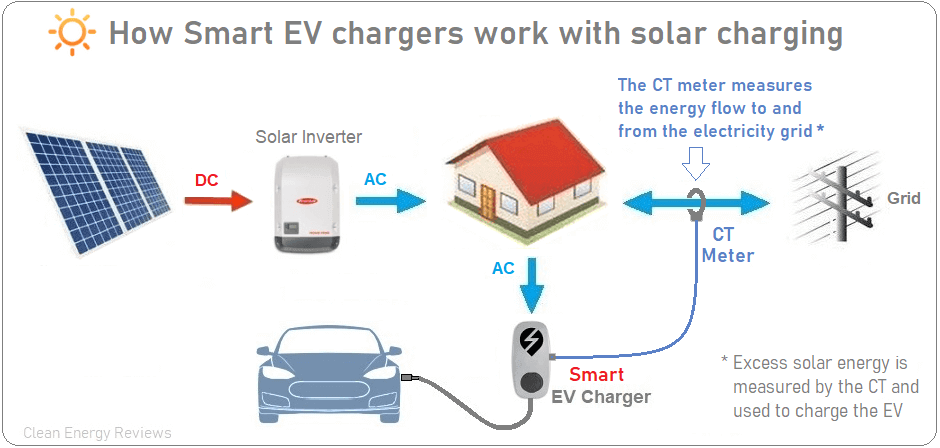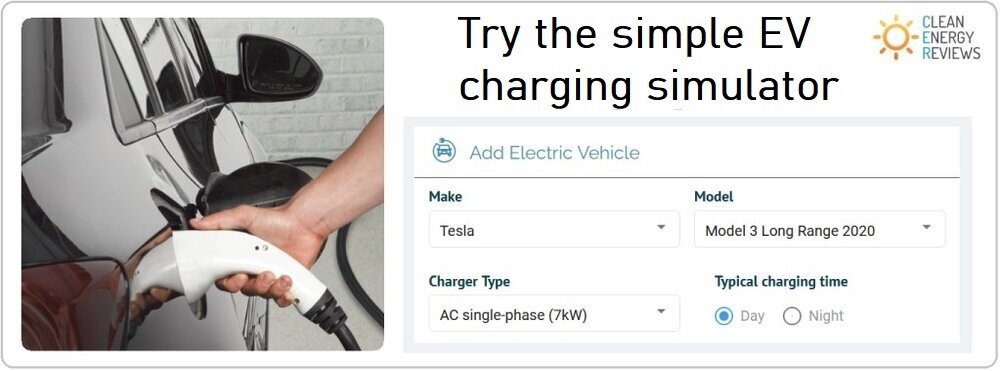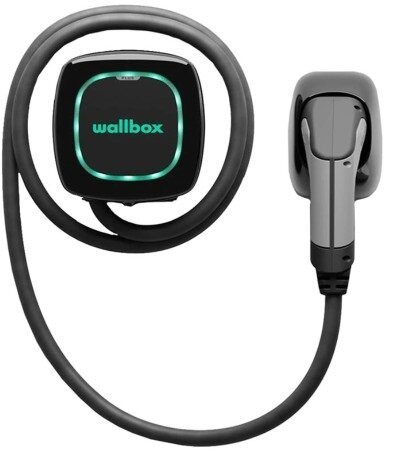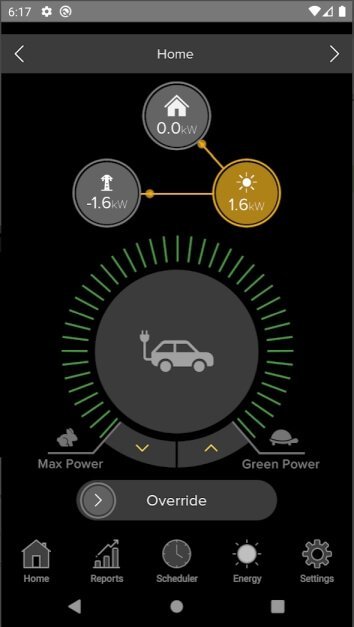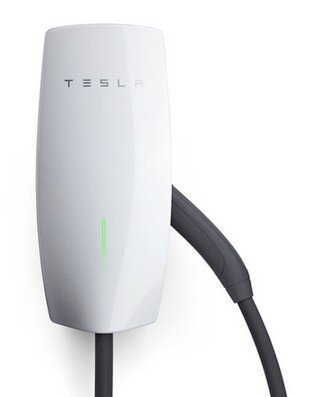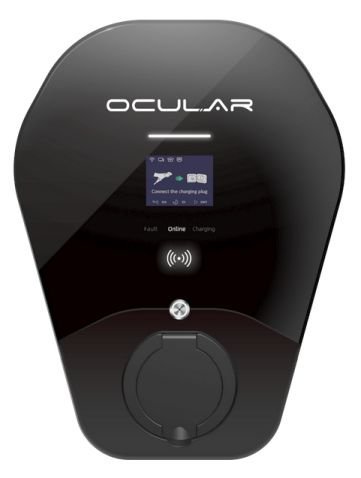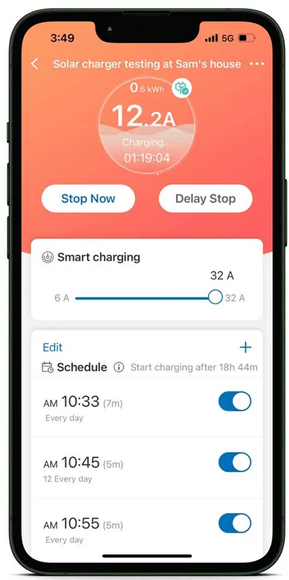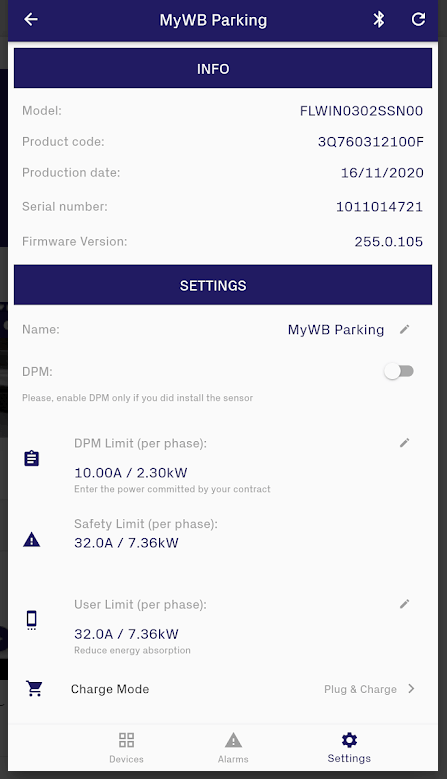Best Smart EV Chargers
What is a Smart EV charger?
Electric vehicle chargers are becoming more sophisticated as manufacturers seek to make EV charging easier and more cost-effective for homes and businesses. Smart EV chargers allow automatic charging to occur when electricity prices are low or when solar power is being generated. Regular home chargers can draw a lot of power, so intelligent monitoring and controls help prevent overloading the grid supply. In addition to helping optimise EV charging, most smart chargers now have Wifi and Bluetooth as standard to enable easy setup and monitoring using a mobile app.
Is extra hardware needed for smart charging?
Smart charging modes can only be enabled if the EV charger can obtain data about solar generation or other electricity-consuming loads. Generally, to monitor the solar and loads, external sensors or CT meters are needed to gather and transmit the data back to the charger. Alternatively, EV chargers that are OCPP (Open Charge Point Protocol) compliant can be configured for remote control using external software such as Charge HQ. External meters are not required if all the equipment is compatible with OCPP. We’ll explain this in more detail later.
Smart EV charging modes
Smart EV chargers have numerous options to optimise charging, reduce charging costs and increase self-sufficiency using solar. The most common feature is solar EV charging and charge scheduling using cheaper off-peak electricity. Another very useful smart charging mode is Load Balancing; this is where the charge rate is dynamically adjusted to ensure the charger doesn’t overload and trip off the electric supply when other high-power appliances (loads) are running. Load-balancing is very important if more than one EV charger is installed or the electricity supply is limited.
Solar Charging
EV charging using a home solar system appeals to many people as it dramatically reduces the vehicle's operating cost and increases self-sufficiency. However, this is difficult if you cannot optimise the charging rate to match your solar generation. For example, many level-2 home chargers have a maximum charging rate of 7kW, but most residential solar inverters are rated at 5kW, and the amount of solar may be far less, especially during poor weather. Luckily, this is where smart EV chargers can help. Unlike regular EV chargers, which are set at a fixed charge level, Smart EV chargers can adjust the charge rate to match your solar generation. To operate, smart chargers require a CT meter to measure energy flow and enable advanced features such as solar-only charging and load balancing. In most cases, the CT meter must be connected to the charger via a communication cable (CAT5/6), but CT meters from a select few brands can be wirelessly connected. Learn more about solar EV charging here.
Load-balancing
EV chargers use a lot of power which can cause issues for some homes or businesses if too much power is drawn from the grid. Fortunately, this is where load-balancing can help. This feature is available on most smart chargers and is particularly useful for households with a limited grid supply or businesses with multiple EV chargers installed.
How it works - Load-balancing enables an EV to charge at the maximum rate when the household or business loads are low. If electricity consumption increases due to other high loads, the charge rate will drop automatically to prevent tripping the main supply circuit. This is also useful for homes or businesses with more than one EV charger, as it prevents overloading the grid supply when multiple EVs are charging simultaneously. For load-balancing to work, an external energy meter (CT) is required to measure and dynamically adjust the charge rate depending on the other loads in the building.
Scheduled charging
To reduce EV charging costs, most smart EV charger chargers can be set to charge when the electricity rates are low. The cheapest (off-peak) rates are generally during the night when most people are sleeping, so a pre-set off-peak charging schedule can automatically charge the EV overnight. Electricity demand is at its highest during the evening, which is also when electricity tariffs are typically very high. EV charging during these periods costs you more and places a greater strain on the electricity network, which can already be stretched to its limits during extreme heat waves.
What is OCPP
OCPP (Open Charge Point Protocol) is an open-source communication language developed by the Open Charge Alliance (OCA) to enable EV chargers to communicate with an external control system. Chargers with OPCC communication support can allow software such as Charge HQ to control the charger and enable Solar-only charging and load-balancing without needing a CT meter. However, the solar hardware must also be OCPP compliant for this to work. For instance, Charge HQ must also be able to monitor the solar inverter to adjust the EV charger dynamically depending on the solar generation. For more information and for those new to EV charging and solar, see our introduction to home solar electric vehicle charging.
Top 12 Smart EV Chargers
Below is a comparison table of the Top 12 smart home EV chargers for 2024. Full charger details are shown below.
(*) additional components are required (purchased separately) to enable solar-only charging.
1. Smappee EV Wall
Smappee is a cleantech company based in Belgium specialising in smart energy management systems for homes and businesses. The company developed the unique Smappee Infinity, an advanced energy monitoring system used to analyse real-time use of electricity, solar power, gas and water. The EV Wall, released early in 2021, includes the Infinity system to offer advanced smart charging modes and scheduled charging options to maximise solar self-consumption.
The Smappee EV Wall smart EV charger is available in single-phase (7.2kW) or 3-phase (22kW) options. While the price is relatively high, the package includes three CT meters plus a hub for energy monitoring, smart solar charging, and dynamic load control. The integrated infinity system is expandable with up to 28 circuits and can provide full appliance-level data. Plus, it allows users to control the energy flow of excess solar energy to the EV wall charger, battery storage, or any smart device to maximise self-sufficiency.
See detailed Smappee EV Wall review and photos.
The EV wall system is also interoperable with IoT products, is OCPP compatible, receives over-the-air updates, and can be operated and configured for payments via QR code or RFID (card activation).
Basic Specifications
Power rating: (32A) 7.4 kW (1-Phase) / 22 kW (3-Phase)
Size (H,W,D): 300mm x 300mm x 110mm
Compatible with Type 2 sockets
Price: AU$1900, £950
Features
True smart EV charger with multiple smart charging options
Includes CT meters for solar and consumption monitoring
OCPP 1.6 compliant
Smart (AI) optimised solar charging
User-adjustable from 6A to 32A
Dynamic load balancing
Smart app control with real-time and historical energy data and costs
Start and pay via QR code, RFID and control via smart EV schedules
Expandable with Smappee Infinity for full home energy management
Tethered with 2.5m or 8.0m cables, or untethered options available.
2-years warranty (Extendable to 5 years)
Cons
Expensive
Large
Download the Smappee EV wall datasheet
2. Wallbox Pulsar Max
The Wallbox Pulsar Max EV charger
The Wallbox Pular Max is great for those looking for a compact and discrete EV charger that can be remotely controlled and locked. The Wallbox app is Google and Alexa compatible, enabling scheduled charging times to take advantage of cheaper off-peak electricity rates.
The Wallbox Pulsar Max now features load-balancing and smart solar charging when used in conjunction with an add-on energy meter called the EMS (energy management system). The EMS enables several smart functions, including Power boost, Eco-mode and dynamic power sharing, which adjusts the charging rate when multiple chargers are used from the one grid connection to ensure it does not overload the supply. Power boost mode enables the system to charge at the maximum rate when the other loads are low.
Basic Specifications
WiFi and Bluetooth-enabled smart charger
Power rating: 7.4 kW (1P) / 11 kW (3P) / 22 kW (3P)
Compact size: 166mm x 163mm x 82mm
Price: AU$ 1350, US$ 650, £550
Features
Scheduled charging times
User-adjustable from 6A to 32A (40A for US version)
OCPP 1.6 compliant
Dynamic load-balancing (with optional EMS)
Power boost and Smart-ECO modes
Lock and unlock the charger via the App for added security
Long 5m charging cable with 7m option (25 ft for US version)
myWallbox portal allows multiple users and charging history
Google Assistant and Amazon Alexa compatible
Easy firmware updates
Cons
Additional energy monitoring meter needed to enable solar-optimised charging
Download the Wallbox Pulsar Max datasheet
The smart Zappi V2 electric vehicle charger from Myenergie
3. Zappi V2
The UK-made Zappi V2 charger from Myenergi is one of the most popular EV chargers on the market. It’s a clever device with three different charging modes, eco, eco+ and fast. It can also be set up as a single-phase or 3-phase charger with 1 phase charging rate from 1.4kW to 7kW and 3 phase from 4.1kW to 22kW.
In Eco mode, it will charge your EV using mostly self-generated solar power while minimising the amount of grid power used. In Eco+ mode the Zappi charger will quickly adjust its charge rate to only use your own excess solar generation and will not push any grid power. This means it will pause charging if your household is consuming all the solar generation or the weather is very poor. In Fast mode, the Zappi will charge your vehicle at the maximum rate regardless of solar generation or household consumption. The Zappi is also the only charger that offers wireless CT (energy monitoring) data via the optional Harvi wireless sensor. Note, CTs are extra and are not included with the Harvi unit.
Basic Specifications
The Zappi V2 display showing the solar and EV charging status in smart ECO+ mode
Power rating: (30A) 7.0 kW (1-Phase) / 22 kW (3-Phase)
SSize (H,W,D): 439mm x 282mm x 122mm
Compatible with Type 2 sockets, Type 1 adapter required
Price: AU$1500, £800
Features
True smart charger with 3 charging modes (Fast, Eco and Eco+)
External 100A CT sensor for consumption monitoring
Wireless CT readings available via Harvi (optional)
Two solar self-use charging modes (Eco and Eco+)
User-adjustable from 6A to 30A
Graphic LCD display
Boost option for rapid charging at max charge rate (32A)
Dynamic load balancing
Tethered (6.5m) and untethered options are available (removable cable)
3-year warranty
Cons
Remote access (App) optional extra via Myenergyi HUB
CTs are an optional extra
Not OCPP compliant
Download the Myenergi Zappi datasheet
4. Anderson A2
The Anderson A2 charger is a very stylish smart EV charger that had been precision-designed for quality and function. It features a range of energy management functions including solar-only charging, smart scheduling and dynamic load-balancing. The charger is available in 7.0kW single-phase or 3-phase 22kW varieties with adjustable current settings and monitoring via the smart Konnect app.
However, what really sets this charger apart from the competition is the high-quality enclosure built on a machined alloy base and the vast array of customisable colour and cover options available. The unique design also hides both the cable and connector inside a seamlessly integrated cavity. The only real downside is that it is only available in the UK and Europe.
Basic Specifications
Power rating: (32A) 7.0 kW (1-Phase) / 22 kW (3-Phase)
Size (H,W,D): 494mm x 348mm x 148mm
Compatible with Type 2 sockets, Type 1 adapter required
Price: £980 (UK and EU only)
Features
True smart charger with various charging options
Solar only charging (with external CT)
OCPP 2.0 compliant
Scheduled charging times
User-adjustable current (A) setting
Dynamic load balancing (optional CT)
Over the air updates via inbuilt Wifi
High-performance ultra-flexible Evoflek cable (5.5 or 8.5m)
Precision engineered alloy mounting frame
A wide variety of colours and cover panels are available
3-year warranty (only if it was installed under OZEV Homecharge Scheme)
Cons
Expensive
External CT meter for smart controls is an optional extra
Only available in the UK and Europe
Download the Anderson A2 datasheet
5. Ohme Home Pro
Ohme, founded in 2017, is a British company specialising in smart charging solutions. The company’s product lineup includes the Home Pro, a tethered charger with a built-in LCD screen, and the ePod, an untethered, compact charger. Both models are available in single-phase and 3-phase varieties and feature dynamic charging and solar charging compatibility, enabling users to maximise solar generation and minimise costs.
Ohme's chargers are the first to integrate with dynamic energy tariffs, enabling flexibility and savings for users on variable electricity plans. The system is compatible with all energy providers in the UK, including Octopus and OVO smart EV tariffs. The company will also launch dynamic tariff integration with Amber & OVO in Australia in early 2025.
Another standout feature is EV battery state of charge (SoC) tracking, allowing for precise charge tracking and management. This functionality supports Tesla vehicles in Australia, the UK, and Europe. Ohme is working on compatibility with numerous European EV brands, and additional models are set to be supported throughout 2025.
Basic Specifications
Power rating: (32A) 7.4 kW (1-Phase), 22 kW (3-Phase)
Size (H,W,D): 200mm x 170mm x 100mm
Compatible with Type 2 sockets, Type 1 adapter required
Price: AU$ 1400, € 600
Features
Solar charging (with included CT)
Dynamic load balancing
Dynamic variable tariff-based charging
Vehicle SOC tracking and charge options (Tesla)
Scheduled charging times
User-adjustable from 6A to 32A
Integral PEN protection - no earth rod or RCBO/consumer unit required
Internal electronic RCD Type A 30mA (AC) and 6mA (DC)
Wi-Fi and Bluetooth
Optional 3G/4G comms (cost covered by Ohme for the first 3 years in the UK)
Over-the-air firmware & software upgrades
3-year warranty
Cons
No untethered option is available
No OCPP option
Download the Ohme Home Pro datasheet
6. EO Mini PRO 3
The new EO Mini Pro 3 smart EV charger
EO is a well-known UK manufacturer of EV chargers. The new Mini Pro 3 is the third generation super-compact smart charger, and like its larger brother, the new EO genius, it is packed with features. If you want a small, discrete, modern-looking charger with clever charging options, it would be hard to pass by the Mini Pro 3. Like most single-phase chargers, it has a maximum charging power of 7.2kW or 32A but can be ramped down if your supply circuit is limited. It’s set up and controlled via Wifi through the EO app and displays the current charging rate plus it logs the charging history.
EO Mini Pro 2 smart app with three charging options
The EO Mini Pro 2 offers three charging options: off-peak charging, solar charging, and scheduled charging, which can be configured to suit your requirements. However, the energy meter (CT) is required to enable solar-only charging, and load balancing is an optional extra.
Basic Specifications
Power rating: (32A) 7.2 kW (1-Phase), 22 kW (3-Phase)
Size (H,W,D): 215mm x 140mm x 100mm
Compatible with Type 2 sockets, Type 1 adapter required
Price: AU$ 1500, € 650
Features
True smart charger with 3 charging options (Optional CT)
Solar-only charging (with external CT)
OCPP 1.6 compliant
Off-peak charging setting
Scheduled charging times
User-adjustable from 6A to 32A
RFID optional extra
Integral PEN protection - no earth rod or RCBO/consumer unit required (7.2kW only)
Dynamic load balancing (optional CT)
Wi-Fi, Cat 5 Ethernet, Bluetooth, (4G optional extra)
Tethered and untethered options are available (removable cable)
3-year warranty
Cons
External CT meter for smart modes is an optional extra
Download the detailed EO Mini PRO 3 datasheet
7. Tesla Gen 3 Wall Connector
The Gen 3 Tesla (soon to be smart) wall connector EV charger
The third-generation wall connector from Tesla has some significant updates, the most convenient being the WiFi connection. Although more significantly, this is the first Tesla charger that can be used to charge any EV, not just Tesla’s (using an adapter). After several years, the solar charging option has finally been enabled. Unfortunately, solar-optimised charging is only available when the charger is used with a Tesla Powerwall battery and EV.
Further enhancements include the power-sharing (load-balancing) setting, which can dynamically manage up to 3 Tesla EV chargers. However, the best selling point of Tesla’s latest EV charger, besides the sleek white glass faceplate, is the low price point, about 30% lower than most of the competition. The charge rate can also be adjusted via the App, but only when used with a Tesla EV.
Basic Specifications
Power rating: 7.4 kW (1-Phase) / 16 kW (3-Phase)
Size: 345mm x 155mm x 110mm
Compatible with all Electric Vehicles, Type 1 & 2 adapters required
Price: AU$ 760, US$ 450
Features
Low-cost WiFi-controlled EV charger
Power Sharing (load-balancing) with up to 3 Wall Connectors
User-adjustable from 6A to 32A (Tesla vehicles only)
Smart charger when used with a Tesla EV and Charge HQ.
Solar-only charging - when used with a Powerwall and Tesla EV.
Scheduled charging times
Tethered with an extra long 7.3m cable
Automatic charging restart in the event of a blackout
4-year warranty
Cons
Solar charging features are only available with a Powerwall and Tesla EV.
Limited functionality when used with a non-Tesla EV.
Download the Tesla Wall Connector datasheet
8. Ocular IQ Solar
OCULAR is a popular EV charger company based in Australia that has developed a wide range of EV chargers for residential and commercial applications, including high-power DC chargers. The IQ Wallbox was the first Smart EV charger produced by Ocular. The new IQ Solar enables smart solar charging and is available in either two sizes: single-phase 7.4kW or 3-phase 22kW. The sleek black, tear-drop-shaped charger features a clear 2.8-inch LCD display, RFID, Ethernet and Wifi, and OPCC1.6J, making it suitable for the Charge HQ app-based control system for solar charging optimisation.
Load balancing is also available, and the CT clamp (external monitoring hardware) is supplied. The charge current is adjustable via the easy-to-use mobile app, along with multiple charge scheduling options.
Basic Specifications
Power rating: 7.0 kW (1-Phase) or 22 kW (3-Phase)
Size: H360mm x W239mm x D146mm
Compatible with Type 2 sockets, Type 1 adapter required
Price: AU$ 1500
Features
Solar-only and solar-assist charging options
Scheduled charging times
Large 2.8” screen
OCPP 1.6 compliant communication protocol
RFID security
optional inbuilt 4G modem
User-adjustable charging
Dual API for integration across platforms
Dynamic load balancing (optional CT)
2-year warranty
Cons
Expensive
Download the Ocular IQ Solar Datasheet
9. ZJ Beny BCP Series
Founded in 2011, ZJ Beny is very well known among solar installers as a manufacturer of reliable, cost-effective solar isolators and surge protection equipment. The BCP series is the first EV charger released by the company and offers a huge array of features at a very affordable price. In fact, with a price tag as low as $650 (including one CT meter for load-balancing), it’s by far the best-value smart EV charger on the market. However, the snap-on cover, plastic housing and retro-looking DLB (Dynamic Load-Balancing) module look a little cheap, but for most users, the aesthetics will not be a big issue.
To enable solar-only charging or load-balancing, the new, redesigned (din-mounted) DLB box is required. See details and photos.
The charger is available in either untethered or tethered options with a 6m (18ft) charging cable and single or 3-phase varieties with fully adjustable power ratings from 1.3kW or 7.4kW single-phase and 4.1kW to 22kW 3-phase. Regarding communications, WiFi and Bluetooth are standard on all Smart versions, while OCPP 1.6 Json communication protocol is optional (refer to the model selection chart on the datasheet). Strangely, the OCPP version is different to the regular version and has some functional limitations. The Z-Box App used to set up and monitor the charger has a simple and easy-to-use interface and offers a huge range of configuration options.
Basic Specifications
Power rating: 1.3kW to 7.4 kW (1-Phase) or 4.1kW to 22 kW (3-Phase)
Size: W169 mm x H380 mm x D151 mm
Type 2 sockets
Price: from AU$ 650
Features
Very affordable Smart charger with multiple charging options
User-adjustable current (A) setting from 6A to 32A
Solar charging only (with CT fitted)
OCPP 1.6 compliant version available
Scheduled charging times
Dynamic load balancing (DLB) CT meter included
OCPP 1.6 Json communication protocol (Optional)
PEN fault detection (optional)
Tethered and untethered options are available (removable cable)
RFID security
3-year warranty
Cons
Plastic front cover feels a little flimsy
The OCPP version lacks some functionality
Download the detailed ZJ Beny BCP Series EV charger datasheet
10. Hypervolt Home 3 Pro
Hypervolt is a relatively new UK-based company launched in early 2021 that manufactures smart home EV chargers for the UK, European and, more recently, Australian markets. The company currently produces only one EV charger, the single-phase Hypervolt Home 2.1, which is packed with features and has enjoyed very good feedback from installers and customers alike.
Like most single-phase chargers, the Home 2.1 has a maximum charge power rating of 7.0kW (32A) and is set up and controlled via an App using either Wifi or Bluetooth. It features a range of smart-charging options, including solar charging, load-balancing, and scheduled charging, including tariff-based charging options.
Basic Specifications
Power rating: (32A) 7.0 kW, (22kW 3-Phase due late 2023)
Size (H,W,D): 328mm x 243mm x 101mm
Compatible with Type 2 sockets, Type 1 adapter required
Price: AU$ 1350, £ 700
Features
True smart charger with 3 charging options
Solar-only charging
Dynamic load balancing
Scheduled charging.
User-adjustable from 6A to 32A
Smart home integration (Alexa)
Integrated PEN protection - no earth rod or RCBO/consumer unit required
Energy tariff-based charging
Wi-Fi and Bluetooth connectivity
Different tethered cable lengths available 5m, 7.5m and 10m
3-year warranty (5 years optional)
Cons
Tethered option only available. No non-tethered version
No OCPP option
Download the Hypervolt Home 3 Pro datasheet
11. FIMER Flexa AC Wallbox
The FIMER Flexa AC Wallbox is a high-performance smart EV charger designed and manufactured by one of the world's leading power conversion equipment providers. The Flexa is available in tethered and non-tethered versions and four different power ratings, including 3.7kW or 7.4kW single-phase and 11kW or 22kW 3-phase options.
The Flexa AC Wallbox is available in three different levels, Stand-alone, Future Net and Inverter Net. However, only the last two options have load balancing and smart communication features. The Future Net version enables remote monitoring and control, 3G/4G connectivity, WiFi, Ethernet, OCPP 1.6 Json communication protocol. The Inverter Net version includes all the same features, plus it can directly interact with the FIMER React 2 home solar battery system. In addition to the common load-balancing and smart scheduling features, the Flexa future net charger also features an inbuilt AC relay switch and digital input and outputs.
Basic Specifications
Power rating: 3.7kW or 7.0 kW (1-Phase) / 11kW or 22 kW (3-Phase)
Size: 275 mm x 480 mm x 140 mm
Type 2 or Type 3A sockets are available
Price: AU$ 1500
Features
Smart charger with multiple charging options (Optional CT)
OCPP 1.6 compliant
Scheduled charging times
Dynamic load balancing (optional CT)
Inbuilt AC relay switch
Digital inputs and outputs
OCPP 1.6 Json communication protocol
Master and slave configuration for multiple chargers
Tethered and untethered options available (removable cable)
RFID security
3-year warranty (TBA)
Cons
Expensive
Load balancing features require an optional CT (TA meter)
Download the detailed FIMER Flexa AC Wallbox datasheet
12. Enel x Juicebox 40
The JuiceBox 40 from Enel x is one of the most popular EV chargers in North America and is designed specifically for the US market. The charger is very affordable and rated higher than most, with a maximum charge rate of 40A or 9.6kW at 240V. Other features include scheduled charging, inbuilt WiFi and voice control via Google or Alexa.
The Juicebox load-balancing feature is unique in that it is software controlled and does not require external CT metering. This is great when multiple chargers are connected to one grid supply point, but it will not enable dynamic load-balancing with a single charger. Juicebox owners can also participate in smart grid programs to enable charging from renewable sources and reduce emissions.
Basic Specifications
Power rating: (40A) 9.6kW (240V)
Size: H469mm x W173mm x D147mm
Compatible with Type 2 sockets, Type 1 adapter required
Hardwired or Plug-in option (NEMA 14-50R outlet)
Price: US$ 680 (US only)
Features
Smart charger with charging options (Optional CT)
OCPP 1.6 compliant
25 ft cable (7.6m) with SAE J1772 standard plug
Scheduled charging times
RFID security
User-adjustable from 6A to 40A
Dynamic load balancing (optional CT)
Built-in cable rack and security lock
3-year warranty
Cons
No solar only charging option
External CT meter for load-balancing is an optional extra
Download the detailed Enel X JuiceBox 40 datasheet


